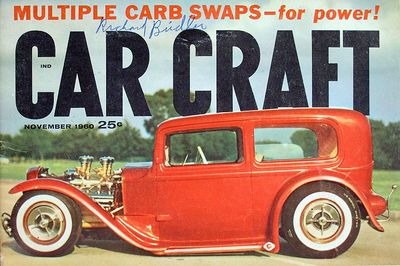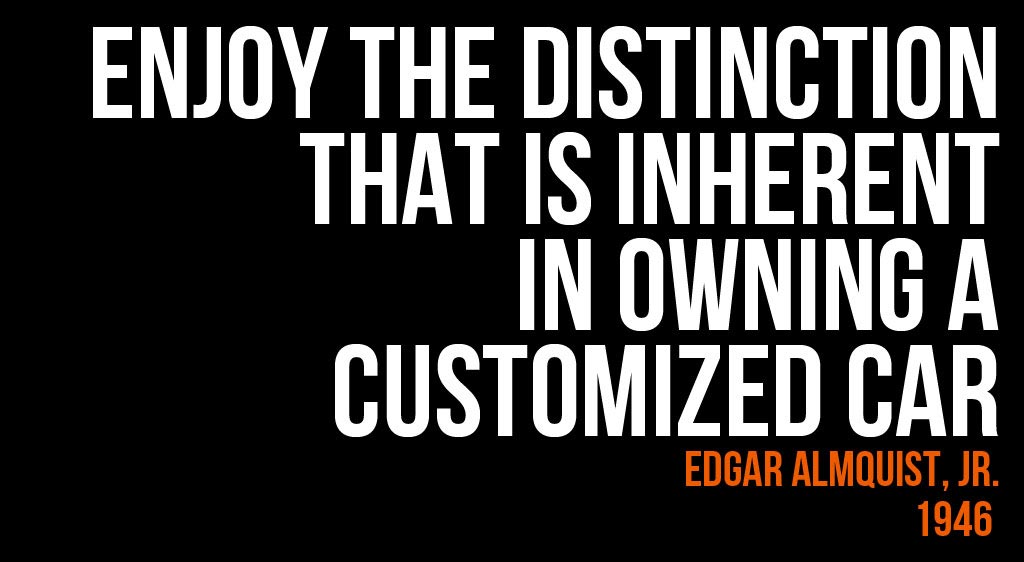George Jezek's 1931 Ford Model A Tudor Sedan
























1931 Ford Model A Tudor Sedan owned and built by George Jezek of Waco, Texas, Jezek has been a dedicated figure in the hot rod and custom car scene since the 1950s. Growing up in a small town near Waco, he developed a passion for cars at an early age, beginning with hand-painted pinstriping and simple modifications to his personal vehicles. His first significant custom project was a 1949 Chevrolet 2-Door Sedan, which underwent multiple transformations and gained national recognition in the early 1960s. Jezek was also a founding member of the Eliminators of West, an NHRA-chartered rod club that provided a communal space for car enthusiasts to build and modify their vehicles.[1]
Contents
The Poor Man's Deuce
Jezek had long admired Dave Stuckey's channeled version of the Deuce Sedan, which would later become the famous Lil' Coffin after appearing on the cover of Car Craft November 1960. However, by the late 1960s, a real Deuce was beyond his budget, so in 1968, Jezek sold his Chevrolet and purchased a 1931 Ford Model A Sedan, what he called a "Poor Man's Deuce." The body cost him just $15, as he bought it from a farmer who was using it as a chicken coop.[1]
Jezek performed all the modifications himself, heavily customizing the car to reflect his vision. The top was chopped 3 ½ inches, and the body channeled 6 inches, giving it a low, aggressive stance. He fabricated a custom firewall and molded cowl, integrating them seamlessly into the body. At the front, he mounted a 1932 Ford grille shell filled with chromed expanded metal, further refining the car’s sleek aesthetic. The front fenders were modified to accommodate lowered headlights, which were tucked beneath small, custom-radiused humps.[1]
The rear of the car featured bobbed rear fenders, which were radiused an extra inch to provide tire clearance and extended to seamlessly meet custom-fabricated running boards. Jezek also fabricated custom splash pans and installed taillights from a 1947 Chevrolet panel truck, blending vintage elements into the build. A black vinyl top completed the exterior. The car's body was finished in a striking candy blue lacquer paint job featuring four-color paneling, while the undercarriage, following Jezek’s signature style, was painted red. The candy blue paint was mixed by Jezek and a R&M dealer in Waco, and he laid it over a silver under base, before topping it with clear.[1]
Chassis and Suspension
Jezek custom-built the chassis from the ground up, Z’ing the frame using 2”x4” steel tubing to achieve the desired stance. The front end was upgraded with a 1965 Chevrolet Corvair independent suspension, while the rear end came from a 1955 Chevrolet, supported by Corvette coil springs. To enhance handling and traction, he installed trussed traction bars at the rear.[1]
The car rolled on 6-inch chrome front wheels wrapped in Firestone tires, while the rear wheels were 8-inch chrome and reversed, fitted with NASCAR tires for a powerful, aggressive look.[1]
Engine and Drivetrain
Under the hood, Jezek installed a 350 Chevrolet small-block V8, paired with an Edelbrock intake manifold and a 780 CFM Holley carburetor for optimal performance. A custom-fabricated set of equal-length tuned headers routed exhaust through the front fenders, a unique touch that added to the car’s radical design. Power was sent to the rear wheels via a Muncie 4-speed manual transmission, controlled by a Hurst shifter mounted inside the cabin.[1]
Cooling was managed by a narrowed 1958 Chevrolet radiator, ensuring the powerful V8 ran efficiently even under high-performance conditions. A custom-fabricated aluminum gas tank was mounted in the rear.[1]
Interior
Jezek carried his custom craftsmanship into the interior, molding a fiberglass dashboard that housed a set of Stewart-Warner gauges, framed in walnut trim. The steering setup featured a Grant steering wheel, mounted on a Corvair steering column, continuing the theme of mixing parts from various GM models.[1]
Seating was provided by custom-molded fiberglass bucket seats, upholstered in black vinyl, maintaining a minimalist yet stylish approach. The pedal assembly consisted of Ansen swing pedals, completing the interior’s blend of form and function. George did all of the work except for the upholstery.[1]
Recognition and Later Years
After completing the build in 1970, Jezek took it to the 2nd Street Rod Nationals in Memphis in 1972. The car had become a showstopper, earning recognition as Street Rodder Magazine's Street Rod of the Year in 1972, winning Best Closed Car for its innovative design and craftsmanship. It was also featured in Street Rodder Magazine October 1972, as well as several other publications, cementing its place in hot rod history.[1]
The following year, at the 1973 Street Rod Nationals in Tulsa, Jezek decided to sell it. The car went to a new owner from Mississippi, marking the end of Jezek’s time with his Poor Man’s Deuce. After changing hands, the sedan resurfaced in Ohio, now wearing a gray paint job but still retaining its original panel-painted layout. However, beyond that point, Jezek lost track of the car’s whereabouts.[1]
Jezek continued his passion for hot rods and custom cars beyond the 1931 Ford Sedan, building and restoring numerous vehicles over the years. His influence in the hot rod and custom car scene remains significant, and the poor man’s Deuce serves as a testament to his ingenuity and dedication to the craft.[1]
Magazine Features and Appearances
Street Rodder Magazine October 1972
References
Did you enjoy this article?
Kustomrama is an encyclopedia dedicated to preserve, share and protect traditional hot rod and custom car history from all over the world.
- Help us keep history alive. For as little as 2.99 USD a month you can become a monthly supporter. Click here to learn more.
- Subscribe to our free newsletter and receive regular updates and stories from Kustomrama.
- Do you know someone who would enjoy this article? Click here to forward it.
Can you help us make this article better?
Please get in touch with us at mail@kustomrama.com if you have additional information or photos to share about George Jezek's 1931 Ford Model A Tudor Sedan.
This article was made possible by:
SunTec Auto Glass - Auto Glass Services on Vintage and Classic Cars
Finding a replacement windshield, back or side glass can be a difficult task when restoring your vintage or custom classic car. It doesn't have to be though now with auto glass specialist companies like www.suntecautoglass.com. They can source OEM or OEM-equivalent glass for older makes/models; which will ensure a proper fit every time. Check them out for more details!
Do you want to see your company here? Click here for more info about how you can advertise your business on Kustomrama.





